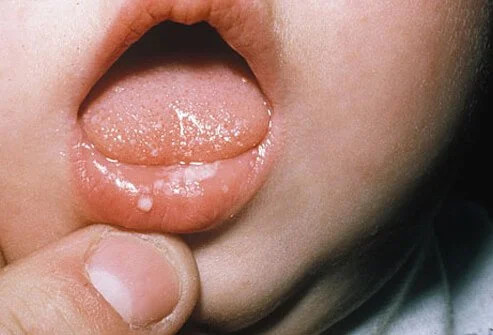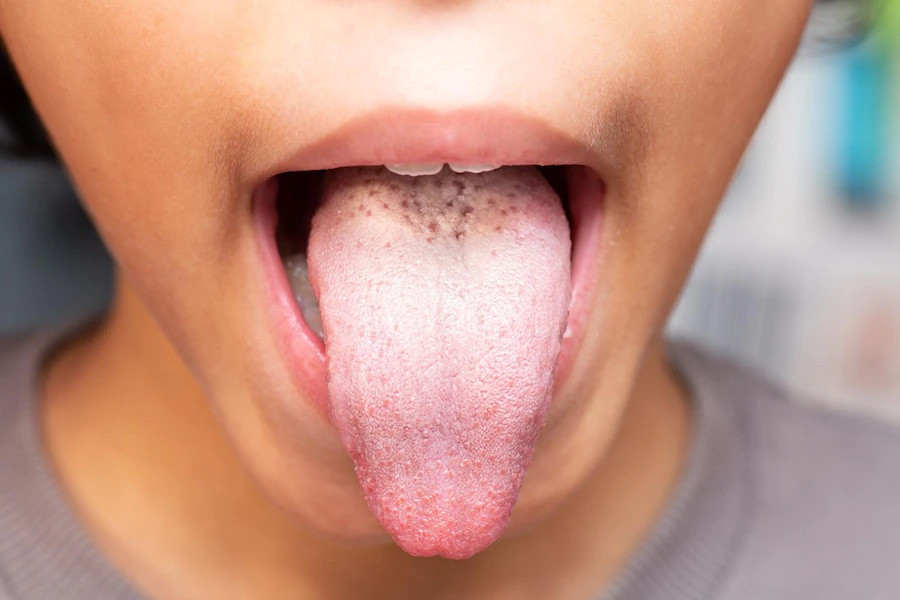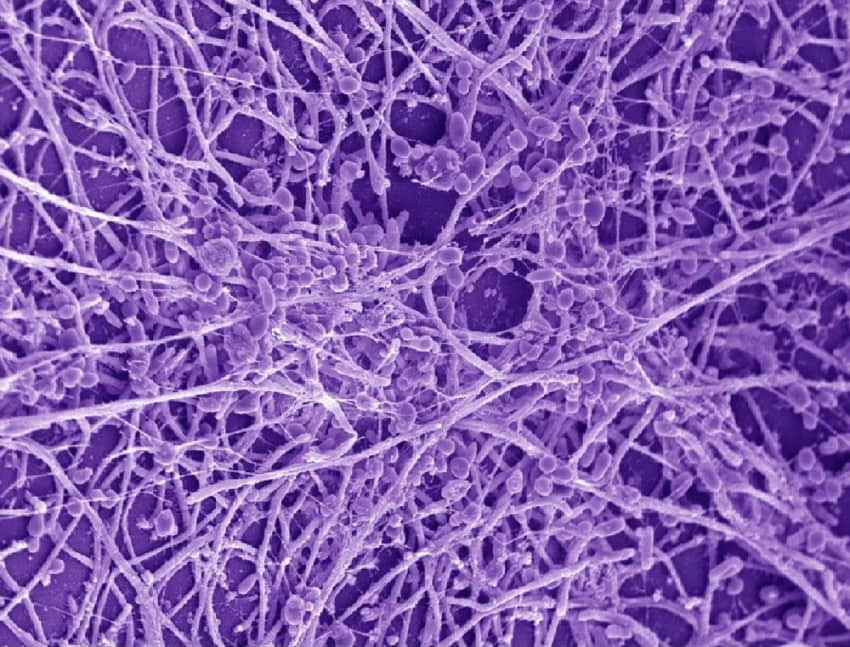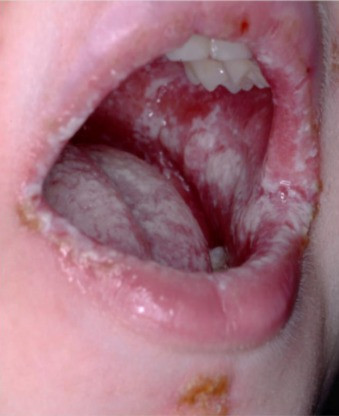Definisi
Kandidiasis adalah infeksi jamur yang disebabkan oleh jamur Candida sp. Spesies yang paling sering adalah Candida albicans. Jamur Candida sp. normalnya hidup di kulit dan bagian tubuh lain seperti mulut, tenggorokan, usus, dan vagina tanpa menimbulkan masalah. Candida dapat menyebabkan infeksi jika tumbuh di luar kendali atau jika masuk ke dalam tubuh.
Kandidiasis dapat terjadi di saluran kemih, organ genital atau kemaluan, mulut dan sekitarnya, atau kulit dan selaput lendir. Pada kasus yang berat, jamur dapat menginfeksi selaput otak, bola mata, jantung, lapisan dinding perut, tulang dan sendi, hingga menyebar ke seluruh tubuh melalui aliran darah.
Penyebab
Candida albicans merupakan bagian dari kuman yang alaminya hidup di tubuh kita. Sebagian besar tidak menyebabkan masalah, kecuali jika perkembangannya berlebihan.
Candida albicans adalah penyebab infeksi jamur tersering. Nama spesiesnya, albicans, berasal dari bahasa Latin yang berarti "putih". Jamur tampak putih saat dibiakkan di atas piring biakan. Dan pada kasus tertentu, Candida albicans menimbulkan bercak putih.
Faktor Risiko
Beberapa faktor risiko kandidiasis adalah:
- Wanita, terutama saat hamil akibat adanya ketidakseimbangan hormon. Umumnya pada trimester ketiga
- Obesitas, karena memiliki lipatan kulit yang lebih besar dan lembab
- Kekebalan tubuh yang lemah seperti pasien diabetes, hiv/aids, atau sedang menjalani kemoterapi
- Neutropenia, yaitu penurunan sel darah putih sehingga pasien rentan terkena infeksi. Neutropenia sering dijumpai pada pasien kemoterapi atau terapi radiasi
- Konsumsi antibiotik atau obat kortikosteroid jangka panjang dan tidak sesuai aturan
- Riwayat dirawat di rumah sakit
- Riwayat operasi besar
- Menggunakan alat medis yang dimasukan ke dalam tubuh seperti selang infus, selang makan, selang kencing, atau katup jantung buatan
- Menggunakan dialisis peritoneal, yaitu cuci darah melalui alat yang dipasang di perut
- Menggunakan gigi palsu
- Memakai pakaian berbahan sintetis dan ketat
- Kebersihan yang buruk atau jarang mengganti pakaian dalam, termasuk jarang mengganti popok pada bayi
- Menggunakan pil KB atau terapi hormon
- Menggunakan semprotan pembersih vagina
Gejala
Kandidiasis Saluran Kemih
Sebagian besar tidak menunjukan gejala. Gejala umumnya berupa:
- Sering buang air kecil
- Sensasi nyeri atau terbakar saat buang air kecil
- Nyeri perut atau panggul
- Terdapat darah pada kencing
Kandidiasis Genital
Gejala kandidiasis genital atau kemaluan meliputi:
- Rasa terbakar saat berhubungan seks atau saat buang air kecil
- Rasa gatal atau nyeri pada vagina atau penis
- Kemerahan, iritasi, atau bengkak pada vagina atau penis
- Keputihan yang tidak normal, encer atau kental, dan berwarna putih
- Ruam di sekitar vagina atau penis
Kandidiasis Oral
Beberapa gejala umum kandidiasis oral atau mulut meliputi:
- Bintik-bintik putih di mulut yang terlihat seperti keju dan dapat berdarah saat disentuh
- Sensasi terbakar atau nyeri di mulut
- Kemerahan di dalam atau di sudut mulut
- Kesulitan makan atau menelan
- Kehilangan indera perasa
- Terasa seperti ada kapas di dalam mulut
Kandidiasis Mukokutaneus
Gejala yang paling umum dari kandidiasis mukokutaneus atau kuliit dan selaput lendir adalah terbentuk ruam merah. Pada beberapa kasus, dapat juga timbul lepuh. Kulit juga dapat menebal atau menghasilkan zat putih seperti dadih.
Candidemia
Candidemia merupakan infeksi jamur Candida sp di dalam aliran darah. Gejala dapat menyerupai infeksi bakteri dalam darah, meliputi:
- Demam
- Gagal ginjal
- Syok atau penurunan tekanan darah yang berat akibat gangguan aliran darah ke seluruh tubuh
Kandidiasis Endoftalmitis
Kondisi ini dapat mengenai satu atau kedua bola mata. Gejala utamanya adalah peradangan bola mata, dan dapat meluas ke jaringan sekitar mata pada beberapa kasus.
Kandidiasis Endokarditis
Endokarditis merupakan infeksi pada jantung. Gejala endokarditis jamur meliputi:
- Demam
- Batuk
- Kesulitan bernapas
- Nyeri tubuh secara keseluruhan, terkadang pada anggota gerak bagian bawah
Kandidiasis Meningitis
Jamur Candida sp juga dapat menginfeksi selaput otak, yang disebut meningens. Gejala meningitis akibat infeksi jamur berupa:
- Sakit kepala
- Kaku leher
- Demam
- Mual dan muntah
- Sensitif terhadap cahaya
- Kebingungan
Kandidiasis Intraabdominal
Gejala kandidiasis intraabdominal atau organ dalam perut, bisa sangat mirip dengan peritonitis bakterial. Gejalanya meliputi:
- Nyeri perut atau kembung
- Demam
- Mual dan muntah
- Merasa lelah
- Diare
- Nafsu makan berkurang
Kandidiasis Osteomielitis dan Artritis
Infeksi jamur Candida sp. juga dapat menyerang tulang dan sendi. Gejala berupa rasa sakit atau bengkak pada bagian yang terkena yang dapat disertai demam, juga keterbatasan gerak pada sendi yang terkena.
Diagnosis
Untuk mendiagnosis kandidiasis, dokter akan menanyakan riwayat kesehatan dan gejala Anda. Dokter juga akan bertanya mengenai kondisi kekebalan tubuh Anda dan apakah Anda baru saja mengkonsumsi antibiotik.
Umumnya kandidiasis dapat didiagnosa melalui pemeriksaan fisik. Jika dokter belum yakin dengan diagnosisnya, dokter akan mengambil sampel dari bagian tubuh yang terkena. Sampel kemudian dikultur untuk mengetahui jenis kuman penyebab.
Misalnya, jika dicurigai candidemia, dokter akan mengumpulkan sampel darah. Pada endoftalmitis, diagnosa melalui pemeriksaan retina dan analisis sampel cairan mata. Jika diduga meningitis, akan diambil sampel cairan tulang belakang dan otak untuk dikultur. Pada kandidiasis intraabdominal, dilakukan pemeriksaan cairan perut. Sementara, diagnosis endokarditis jamur cukup sulit ditegakkan karena gejalanya mirip endokarditis bakteri.
Tata Laksana
Infeksi candida yang paling umum, seperti infeksi vagina dan kulit, terlokalisir pada bagian tubuh tertentu dan dapat diobati dengan obat antijamur. Infeksi candida yang tidak diobati dapat menyebabkan infeksi sistemik atau meluas dan mengenai organ dalam lainnya.
Kandidiasis Saluran Kemih
Pengobatan hanya direkomendasikan untuk pasien yang bergejala. DIgunakan obat antijamur flukonazol sesuai dengan anjuran dokter. Jika menggunakan kateter atau selang kencing, kateter harus dilepas.
Kandidiasis Genital
Infeksi yang ringan atau sedang dapat diobati dengan krim atau pil antijamur yang dijual bebas atau yang diresepkan.
Kandidiasis Oral
Kandidiasis oral diobati dengan obat antijamur pil, cairan, atau tablet. Contoh obat yang digunakan antara lain nystatin atau clotrimazole. Flukonazol oral (minum) dapat diberikan pada kasus yang lebih parah.
Kandidiasis Mukokutaneus
Krim antijamur dapat diberikan untuk mengatasi infeksi kulit, seperti klotrimazol, mikonazol, dan ekonazol. Kulit juga harus tetap kering selama pengobatan. Pada kasus infeksi meluas, pil flukonazol oral dapat diresepkan.
Candidemia
Pengobatan tergantung spesies Candida yang menyebabkan infeksi. Namun, secara umum obat mencakup fluconazole infus, caspofungin, micafungin, atau amfoterisin B. Penggunaan kateter juga harus dilepas.
Endoftalmitis
Pengobatan dapat menggunakan obat amfoterisin B dengan flusitosin atau flukonazol.
Meningitis
Pengobatan yang direkomendasikan adalah amfoterisin B dengan flusitosin.
Intraabdominal Candidiasis
Pengobatan mencakup obat antijamur, seperti flukonazol, amphotericin B, caspofungin, atau micafungin. Penggunaan kateter juga harus dilepas.
Osteomielitis
Pengobatan menggunakan antijamur seperti amfoterisin B dan flukonazol.
Endokarditis
Pengobatan menggunakan flukonazol infus atau amfoterisin B, pengangkatan alat medis yang terinfeksi, atau operasi pengangkatan jamur dari jaringan jantung.
Komplikasi
Wanita hamil lebih berisiko mengalami kandidiasis vagina selama kehamilan. Kandidiasis vagina adalah bentuk penyakit jamur yang sering terjadi pada wanita hamil yang dapat menyebabkan infeksi sistemik pada janin, berat badan lahir rendah, atau kelahiran prematur.
Intertrigo adalah peradangan kulit pada area lipatan yang dapat disebabkan oleh Candida. Peradangan muncul sebagai rasa sakit dan gatal yang dapat menurunkan kualitas hidup. Faktor risiko obesitas, diabetes mellitus, dan kondisi imun yang lemah akan mempengaruhi peradangan dan kekambuhannya. Intertrigo candida biasanya diobati dengan krim nistatin dan anti jamur golongan azole.
Infeksi Candida yang tidak diobati dapat menyebabkan infeksi sistemik yang meluas ke organ lain dan juga menyebabkan sepsis (infeksi menyebar melalui aliran darah).
Kandidiasis usus dapat terjadi sebagai akibat dari terapi antibiotik oral. Kandidiasis bronkopulmonalis adalah komplikasi langka dari penyakit paru yang sudah ada sebelumnya. Septikemia, endokarditis, dan meningitis terjadi sebagai komplikasi akhir pada pasien dengan gangguan kekebalan tubuh dan leukemia. Pada pasien leukemia, kandidiasis sistemik muncul sebagai neutropenia berkepanjangan.
Pencegahan
Deteksi awal yang cepat dapat mencegah perburukan gejala dan komplikasi. Pencegahan kandidiasis lainnya meliputi:
- Diet rendah gula, karena jamur menggunakan gula dan pati untuk berkembang biak
- Jaga berat badan ideal. Orang dengan kelebihan berat badan atau obesitas memiliki lipatan kulit yang lebih besar dan lembap. Kondisi ini mendukung pertumbuhan jamur
- Kontrol penyakit diabetes. Gula darah yang meningkat pada pasien diabetes mendukung pertumbuhan jamur, sehingga pasien diabetes lebih berisiko terkena infeksi jamur. Kontrol gula darah melalui pemeriksaan rutin, konsumsi obat rutin, dan diet khusus diabetes
- Menggunakan baju yang menyerap keringat. Jamur tumbuh subur di lingkungan yang hangat dan lembab. Kenakan pakaian longgar dan berbahan menyerap keringat. Pastikan juga mengganti pakaian basah segera setelah berolahraga
- Hindari membersihkan alat kelamin dengan produk beraroma yang dapat mengiritasi kulit kelamin yang halus. Setelah mandi, keringkan area genital dengan lembut dan menyeluruh
- Hindari douching, yaitu mencuci vagina dengan bahan kimia khusus karena akan membunuh bakteri baik yang mengendalikan jumlah jamur
- Bersihkan vagina dari arah depan ke belakang untuk mencegah penyebaran jamur dari anus ke vagina
- Ganti pembalut atau tampon sesering mungkin
- Gunakan pelindung saat berhubungan seks dengan orang yang mengalami kandidiasis genital. Jika kedua pasangan memiliki gejala infeksi jamur, keduanya perlu berobat untuk memutus rantai penularan
- Konsumsi probiotik. Bakteri baik membantu mengendalikan jumlah jamur
- Gunakan antibiotik sesuai anjuran dokter
- Menghindari mandi atau berendam dengan air panas
Kapan Harus ke Dokter?
Jika Anda mengalami gejala kandidiasis seperti yang disebutkan di atas, konsultasi ke dokter untuk mendapatkan diagnosis dan pengobatan yang tepat. Dokter juga akan menyingkirkan kemungkinan penyebab infeksi lainnya. Kontrol kembali ke dokter jika infeksi tidak merespon dengan pengobatan.
Mau tahu informasi seputar penyakit lainnya? Cek di sini, ya!
- dr Anita Larasati Priyono
Candidiasis. (2020). Retrieved 14 March 2022, from https://www.cdc.gov/fungal/diseases/candidiasis/index.html
Schulman JS. (2018). About candida albicans: natural yeast and problematic infections. Retrieved 14 March 2022, from https://www.medicalnewstoday.com/articles/322722
R AN, Rafiq NB. (2021). Candidiasis. Retrieved 14 March 2022, from https://www.ncbi.nlm.nih.gov/books/NBK560624/
10 ways to prevent yeast infections. (2021). Retrieved 14 March 2022, from https://www.webmd.com/women/guide/10-ways-to-prevent-yeast-infections
Zoppi L. (2020). Methods of preventing a yeast infection. Retrieved 14 March 2022, from https://www.medicalnewstoday.com/articles/how-to-prevent-yeast-infections











